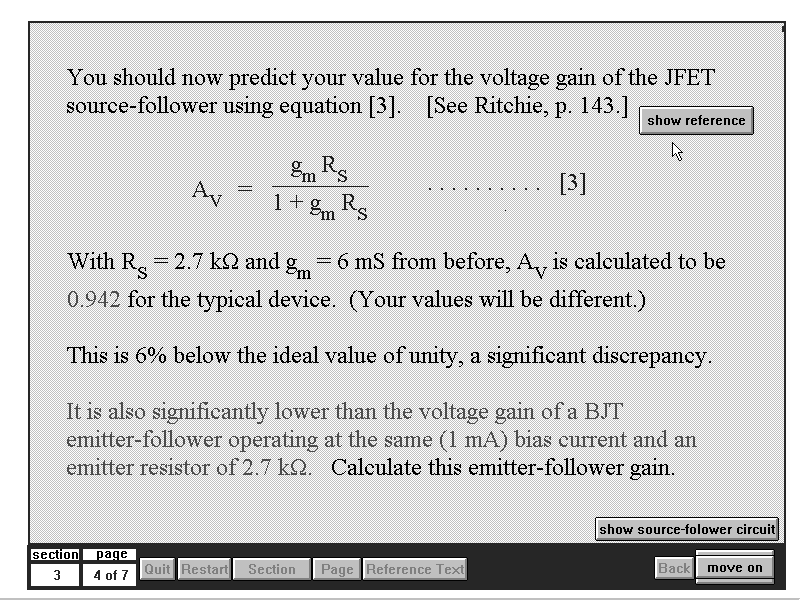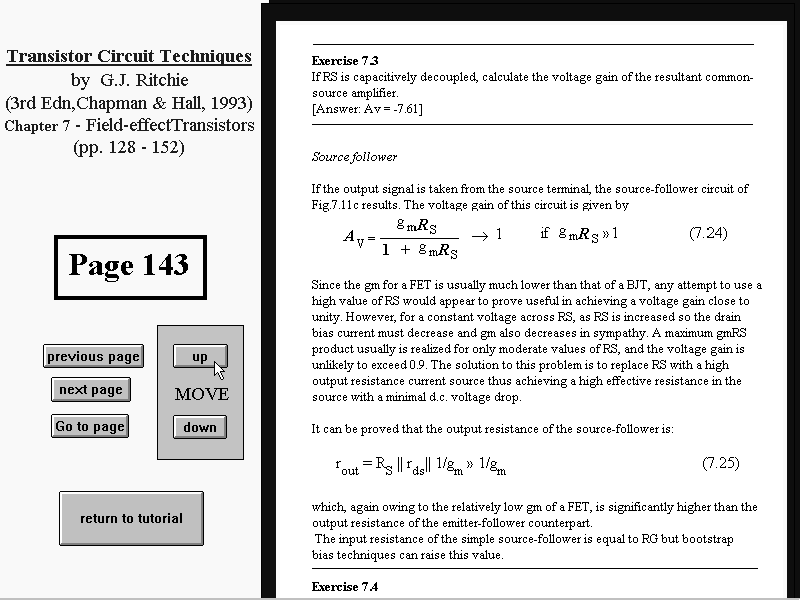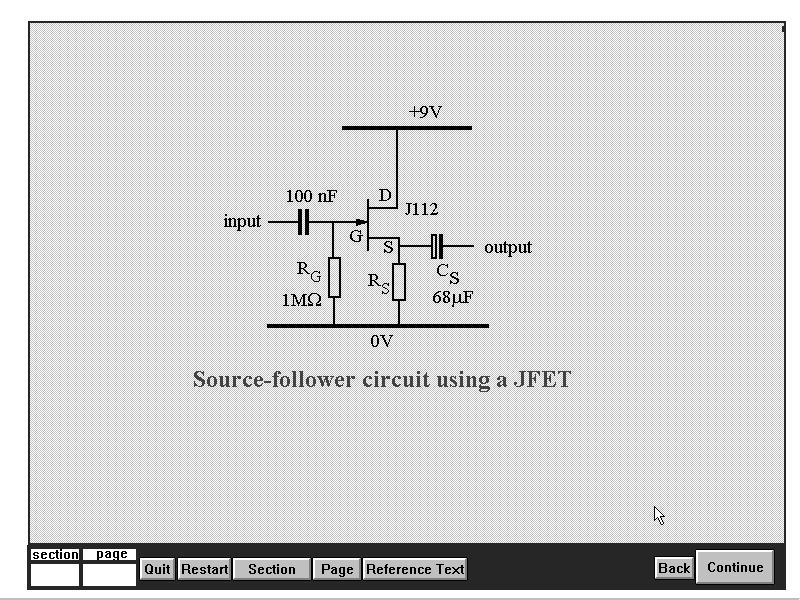

Full Paper



| Full Paper |

|
On-Line Tutorial for Electronic Circuits - Does it Compare with Traditional Tutorials?
Gordon Ritchie
gordon@essex.ac.uk
Department of Electronic Systems Engineering,
University of Essex, Colchester, U.K.
Peter Jones
peterj@ee.uwa.edu.au
Department Of Electrical and Electronic Engineering,
The University of Western Australia, Western Australia
Abstract
In most universities the traditional methods of tutorial support for lecture and laboratory material are increasingly being constrained by reduction in resources. A range of interactive, on-line tutorial material has been generated in-house to enhance the variety of students' learning experience. Use of this self-paced activity is designed to motivate students and help them with their lecture topics as well as in their preparation for laboratory sessions. These were written using Authorware Professional. Several tutorial topics use a common structure to conserve authoring effort. Experience of authoring and running on-line tutorials in the electronics departments of three universities is presented. This work has been very enthusiastically received by students and is recognised as complementing, rather than replacing, traditional tutorials.
Introduction
Today's students are subject to many more pressures than their predecessors, largely due to financial constraints on the institutions as well as on individuals. In these days of worsening student-staff ratios, it is important that learning support and resources are channelled to optimum effect. In laboratory-based subjects there is increasing pressure on facilities and staff, scheduling of access, time for preparation of work by students, availability of library reserve texts. Mature students entering higher education need a variety of academic support; indeed, most students respond to a mix of traditional and alternative methods of studying.
Tutorial provision is a balance between resources and the quality of the student learning environment. On one hand, with small groups or even with one-to-one contact, directed work and assignments are enhanced by dialogue and discussion. On the other hand, with large classes and insufficient resources to support small-group work, engineering tutorials usually assume the format of problems classes; invariably sheets of questions are not tackled in advance and the problems classes degenerate into fair-copy answers sessions with little or no meaningful discussion. However, an instance where large-group classes are successful is in covering revision, for example questions from past examination papers, a situation where there is high motivation on the part of students.
It is unusual to find students who come into the teaching laboratory well-prepared. As a result, the work is unfinished or poorly understood. Since access to laboratory equipment and support staff is limited, it is difficult to recover.
The aim of our on-line tutorial work is to provide an exciting, novel student-support medium which is self-paced. It reinforces, but does not replace, topics within lecture courses and it motivates and encourages students to prepare in advance for laboratory sessions which, in turn, also reinforce the lectures. In each case, students are guided through the material in a structured way; in itself, a valuable discipline. Compared with traditional textbooks, the PC is a novel medium in which full use is made of colour, interaction and animation to reinforce the material.
On-Line Tutorials
Early work on our computer-based tutorials used the bundled software issue of Hypercard (Apple Computer Inc.) package on a MacPlus. Although short-lived, it rapidly established features which have been retained; these include brief revision summaries where appropriate, gradual disclosure of material on some screens, optional questions, a circuit diagrams library and, despite the flexibility of hypertext, a constrained progress through the material. Very soon the work was transferred to Authorware Professional (Macromedia Inc.) running on a PC platform. This opened up the use of colour, larger screens (but still with limited content) and animation as well as having a clear logical structure from the outset.
Painfully aware that authoring time is an immense overhead cost, it was decided to stick with Authorware, not dabbling with other applications, and to have a navigational structure that was common to all the computer-based tutorials. On the navigation bar, see Figure 1, at the foot of the screen, continue and back buttons are provided as well as jump to section, and jump to page; these are blanked when the interaction is within the screen. Perpetual return to contents page and quit buttons complete the standard controls.

Figure 1 - Navigation Bar

Figure 2 - Tutorial Screen
Progression through a tutorial is under mouse-click control with the continue button moved occasionally or other interaction required in order to keep the student's attention. Where relevant, "jump to reference page" and "show circuit diagram" are made available as buttons on the display as seen in Figure 2.
Clicking on the ėshow referenceî button will retrieve the appropriate page from the text as can be seen in Figure 3.

Figure 3 - Reference (page 143) from Tutorial
While clicking on the ėshow source-follower circuitî button takes the student to the display of the corresponding circuit diagram. At any time they can choose to return to continue with the tutorial or, of course, decided not to have diverted off to either the text or the circuit.

Figure 4 - Circuit Diagram
The first on-line tutorial was a collaborative effort between the Universities of Essex and York in the U.K. A laboratory experiment on field-effect transistors was identified with a view to the experiment and its new on-line support tutorial being used in both departments. It was an immediate success with students. They took time (between one and two hours) to prepare in advance for the experiment and, when in the laboratory, showed new-found confidence and competence. Laboratory staff support, which previously had been stretched, became almost unnecessary except that students' questions became stimulating rather than rudimentary.
The theory behind this experiment was supported by a chapter in the textbook written by one of the authors of this paper (Ritchie 1993). Fortunately, a disk version of the text was available and, after much editing to remove typesetting commands and to scan in figures, the chapter was able to be used for on-line referencing directly from the tutorial (Ritchie and Garner 1995). Authorware's JumpFileReturn is used to pass the required page number of the reference and thereby access the specific reference point. It is then possible to browse on either side of the entry page, jump elsewhere within the reference, or return to the exit point from the tutorial. Jumping to and from the reference is fast: approximately one second each on a PC with a 66 MHz 486DX.
The authors recognise the golden rule about not putting too much information on a single screen but also find that there are occasions when it is useful to present a rather detailed summary. As a compromise, a technique of gradual unfolding has been developed. This involves presenting each new section of a screen in foreground tone (or colour) while demoting the previous sections to a background tone which, although subdued, are still legible. In this way, each new section attracts its due attention and then, when the whole screen has been developed, it can be viewed in foreground as a summary. This is a significant advance on textbooks where the presentation is not dynamic.
Animation has been found to have mixed attraction. Naturally, it is a novelty when something moves on the screen - very different from a textbook. However, animation can be overdone. Not only does it take a considerable time to author, it is most frustrating when you are forced to wait for the animation to finish before you can proceed to the next screen. On the first occasion it may be frustrating, on subsequent occasions it is aggravating. For this reason animations have been limited to short sequences or to sequences which can be stopped by the user. One animation (generated at The University of Western Australia) has been particularly enjoyed by students; it animates the input and output voltage levels in a Class-B power amplifier and simultaneously displays the corresponding voltage and current waveforms.
Colour has similar problems. A veritable rainbow of colours is most distracting; it is important to put colour to good use. The authors use a limited range of colours in the screen frame, headings and diagrams; text highlights are in simple red or blue.
Evaluation
Evaluating on-line hypermedia tutorials (Cockerton and Shimell 1997) needs new approaches. We have monitored student reaction to the on-line tutorials by applying questionnaires. From these we have found that the major attraction is the self-paced, step-by-step nature of the presentation. Other major plus points are the targeted nature of the material and the use of colour, interaction and animation.
On-line tutorials have supplemented traditional student support; while only a minimal amount of lecture theatre contact time has been replaced. Students value the face-to-face contact with academic staff and strongly reject wholesale replacement of traditional lectures and tutorials by computer-based activity.
On the negative side, students felt that they should be allowed to take hard copy. This was denied them since the authors felt that it was essential that students were exposed to the logical development of the topics which would not be ensured if they worked from a print-out. Another complaint was that the tutorials use the higher than standard SVGA (800 x 600) resolution which was inappropriate to their lap-top or other older personal machines. This was defended on the grounds of the superior quality considered essential to the presentation, and that more recent laptops and home PCs have the SVGA resolution.
Conclusions
A range of interactive on-line tutorials has been written to enhance the variety of students' learning experience. This self-paced activity motivates students and helps them prepare for laboratories. The work has been enthusiastically received and is recognised as complementary, rather than replacing, traditional large-class tutorials. To quote from a recent report on higher education in the U.K. (Dearing 1997), "New technology is changing the way information is stored and transmitted. This has implications both for the skills which higher education needs to develop in students, and for the way in which it is delivered." We feel that we have gone some way towards that goal with augmenting traditional tutorials with on-line material.
Acknowledgment
The authors acknowledge the contributions of Greville Bloodworth and Paul Garner (both of the University of York, U.K.) to the development of the laboratory tutorials.
References
Apple Computer, Inc. (No date). Hypercard at http://hypercard.apple.com/ [1997].
Cockerton, T., Shimell, R. (1997). Evaluation of a hypermedia document as a learning tool. Journal of Computer Assisted Learning, 13, 2, 133-142.
Dearing, R. (1997). The U.K. National Committee of Inquiry into Higher Education. http://www.leeds.ac.uk/educol/ncihe/
Macromedia Inc. (No date). Authorware at http://www.macromedia.com/index.html [1997].
Ritchie, G.J. (1993). Transistor circuit techniques - Discrete and integrated (Third edition). London: Chapman & Hall.
Ritchie, G.J. and Garner, P.E. (1995). Text referencing within computer-based tutorials. IEE Colloquium on human-computer interface for multimedia electronic books. Digest 1995/038, 1/1-1/3.
(c) Gordon Ritchie, Peter Jones
The author(s) assign to ASCILITE and educational and non-profit institutions a non-exclusive licence to use this document for personal use and in courses of instruction provided that the article is used in full and this copyright statement is reproduced. The author(s) also grant a non-exclusive licence to ASCILITE to publish this document in full on the World Wide Web and on CD-ROM and in printed form with the ASCILITE 97 conference papers, and for the documents to be published on mirrors on the World Wide Web. Any other usage is prohibited without the express permission of the authors.

This page maintained by Rod Kevill. (Last updated: Friday, 21 November 1997)
NOTE: The page was created by an automated process from the emailed paper and may vary slightly in formatting and layout from the author's original.